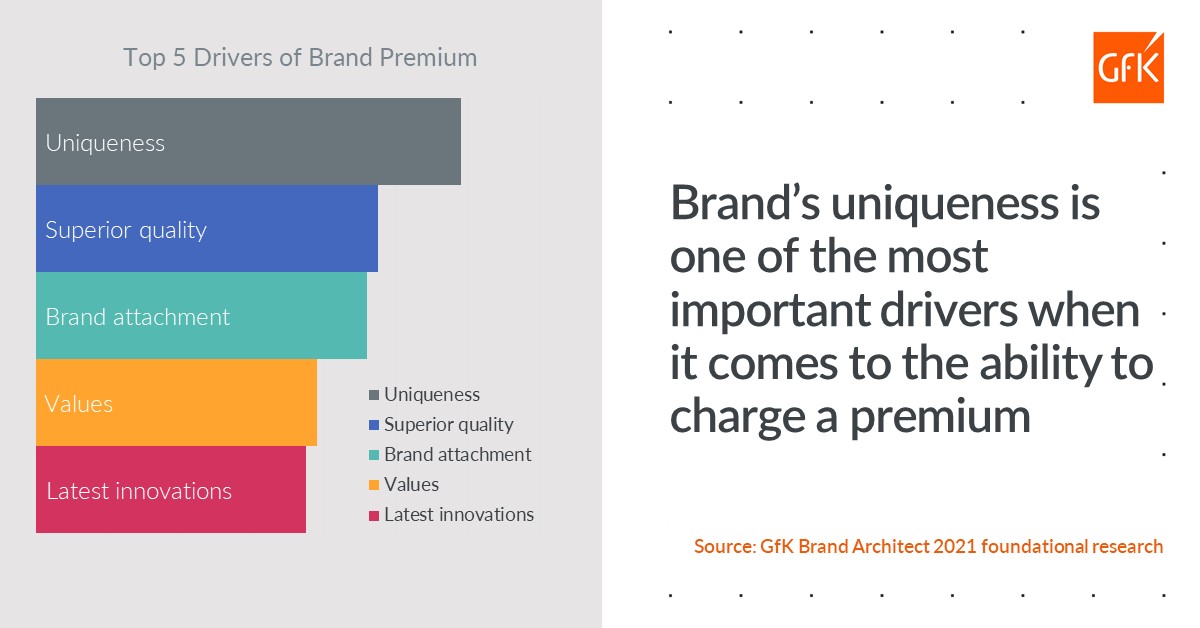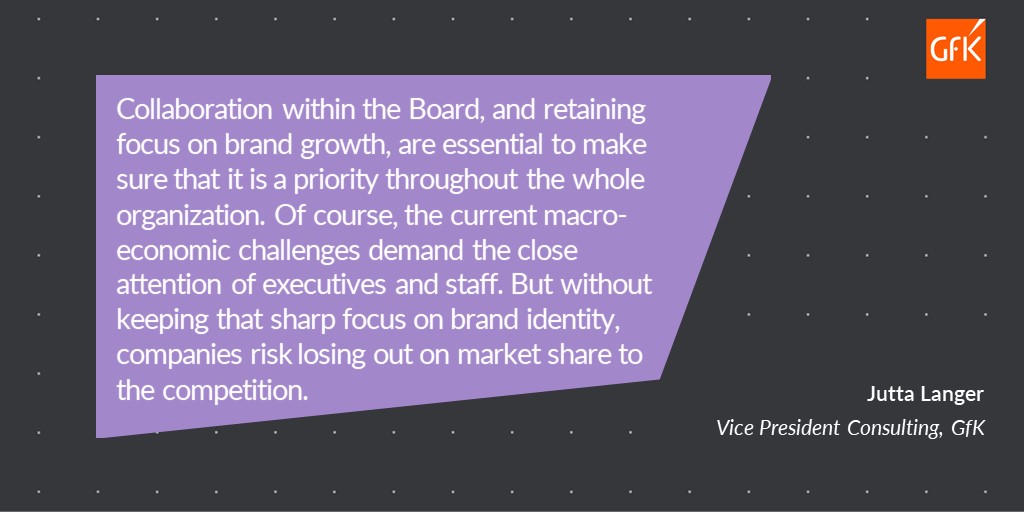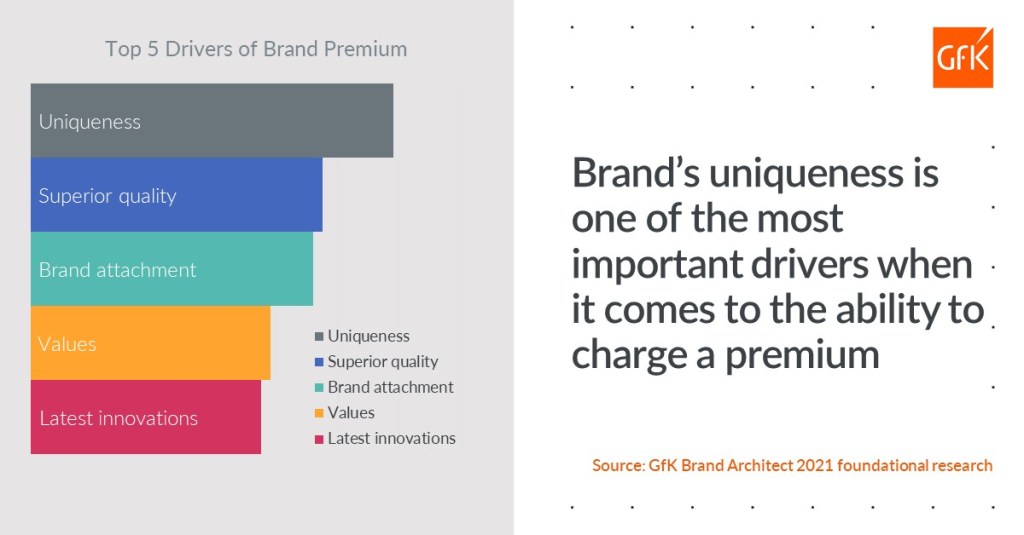Countries around the world are experiencing the highest rate of inflation for decades, with the Organisation for Economic Co-operation and Development (OECD) recently recording an average year-on-year rise of 9.6% in May 2022 across its 38 member countries – the sharpest price increase since 1998. Year-on-year inflation increased for all but a handful of OECD countries, with 10 experiencing double digit inflation.
With the two key drivers being food and energy prices, there are few if any industry sectors that remain unaffected by these inflation levels. Indeed, inflation sits firmly on the agenda for executives running companies of all types and sizes around the globe. So, what can be done to tackle the problem of inflation successfully, so businesses can still achieve sustainable brand growth in a climate of flux and uncertainty?
In this article, gfkconsult suggests five key considerations and action points that business leaders can implement to review their brand strategy and positioning in these challenging times.
In addition, watch this short video for additional information on this topic.
1. Don’t cut marketing budgets – focus on smarter spending for brand growth
When an economic crisis hits, a company’s marketing budget is often the first casualty as businesses strive to mitigate consumer price increases by cutting internal costs. When the COVID-19 pandemic struck in 2020, the Institute of Practitioners in Advertising (IPA) reported dips in UK ad spend of 50.7%, 41% and 40.4% in the second, third and fourth quarters respectively. These figures were reflected worldwide, with all regions seeing a decrease in media budgets, for example by 46% in LATAM.
This is a pattern that has repeated itself throughout recent history, from the USA’s Great Depression in the 1930s through the global energy crises in the 1970s, the 1980s recession and the stock market crash in 2008. And today’s high levels of inflation are now starting to take their toll on ad spend. For example, although digital marketing seems to remain buoyant in the USA, the Standard Media Index reported a 19% drop in linear TV spend for June 2022 – the first decline since the height of the pandemic 15 months ago.
However, history also shows that slashing marketing spend isn’t the best solution when the economic chips are down. A study by McGraw Hill of 600 companies that reduced, maintained or increased their advertising budgets in the 1980s found that those who continued to advertise during the recession saw 256% higher sales than their competitors, post-recession. Those who chose not to advertise saw virtually no increase in market share and a rise in sales of only 18% once the economy began to recover.
Madalina Carstea, Head of Global Solutions, Marketing & Consumer Intelligence at GfK, agrees with these findings, citing the 2008 crash and the 2020/2021 COVID-19 crisis as further examples: “What we learned from both crises is that businesses which continued to invest in their brands, both in terms of communication and innovation, not only secured brand growth in the short-term, but also managed their long-term growth much better.”
“My advice to business leaders is therefore: instead of cutting your budgets, optimize your spending. Make sure you remain visible to consumers and drive ROI from your marketing activities by investing in the right channels for your target audience. Tools such as GfK’s Marketing Mix Optimizer can help you achieve this. Improving productivity is also key at this time to balance out top and bottom-line growth.
“If you do not maintain and optimize marketing spend, there is a very real risk that your brand will be overtaken by competitors who are continuing to advertise despite inflation. And bear in mind there is also an opportunity here. Some of your competitors will probably be reducing their advertising spend right now, helping your business ‘cut through the noise’ – winning yourself a bigger share of voice and driving brand growth in the process.”
2. Find the right way to differentiate your brand from the competition
It’s important to remember that, even in times of economic turbulence, there is still a portion of the market that is willing and able to pay a premium for the products and services they want and aspire to have. And a GfK study in 2021 showed that a brand’s uniqueness is one of the most important drivers when it comes to the ability to charge a premium.

It therefore stands to reason that, for brand growth to be maintained and increased, companies must cultivate a unique identity and image. The way these are spun and presented should clearly differentiate between the brand’s positioning and that of its competitors; the ability to convey this differentiation to customers is naturally key.
Says Madalina Carstea: “It’s crucial to make sure that consumers remain attached and loyal to your brand, and that you find a way to differentiate and stand out so they will pay a premium for your brand. At the same time, consistency is key – and brands must not be distracted from this by the current market context and short-term competitor moves that risk steering them away from their unique positioning.”
The point Madalina makes about brand attachment is critical, as the 2021 GfK study found this to be the second most significant factor for driving premium. She adds: “In order to grow, it’s essential to create and nurture a dedicated community of loyal customers who keep your business ‘top of mind’ and act as brand advocates, helping you bring in new customers. In the current financial climate, customer loyalty is priceless.”
3. Lead brand growth from the top – and make it a priority
For brand-building to be truly effective, it needs to be led from the top. By setting the right example, executives can create a culture and environment that promotes and embeds the company’s brand at every level and throughout every department of the organization.

The British creative agency, Piper, explains this perfectly in a 2021 blog article in which they refer to businesses that champion their brands as ‘brand legends’: “The purpose [of the brand] is driven by the founder and leadership team and everything the brand does emanates from this. They are also custodians of a brand’s external values that naturally reflect the internal culture of the business. A brand legend lives and breathes these values and communicates them confidently, externally and internally.”
4. Ensure brand consistency across all key consumer touch points
Leading on from the above point, teams and departments within an organization must work together to make sure that brand identity and image are presented consistently in all marketing communications and brand-building activities.
Says Jutta Langer: “Brand loyalty is no longer a ‘given’. Executives cannot be complacent about this, as research shows that 59% of consumers have purchased from new brands since the COVID-19 pandemic began. The current cost of living crisis is exacerbating this trend, with 60% of people saying they will stop buying their favorite brands if money is tight and 85% saying they are actively seeking out cheaper alternatives when shopping.
“Collaboration between business functions is therefore becoming more and more critical for brands to achieve growth in these difficult times. In today’s digital age, brand execution is very transparent to consumers. Any inconsistency in brand positioning between product development, marketing communications and sales execution is very visible to them. The battle for gaining attention and engagement in today’s fragmented landscape is difficult enough; a lack of consistency at any point in the customer journey makes brand growth almost impossible.”
In terms of achieving the required level of consistency, access to accurate and current consumer data that represents a single source of truth is indispensable. This will not only drive alignment across the different business functions but also create the necessary resilience to adapt to fast-changing market conditions, whilst helping to prioritize sales and marketing activities.
So, where can this single source of truth be found? Jutta Langer explains. “There are many sources of consumer data available to today’s business leaders. The problem is finding information that is credible and that can be relied on! At GfK, we specialize in providing access to a market-leading collection of consumer insights gleaned from a variety of sources. This includes aligning millions of consumer interviews undertaken worldwide with our unique, highly granular Point-of-Sale data that is collected weekly at store-level.”
5. Understand and segment your audiences
Audience segmentation and understanding has always been important, but never more so than in today’s challenging times. Its importance cannot under-estimated, as segmented email campaigns alone have been found to increase revenues by a massive 760%, whilst non-targeted campaigns have 50% fewer click-throughs.
Indeed, the traditional process by segmenting consumers using geographic, demographic, behavioral and/or psychographic characteristics may not be enough. Today’s consumer has a growing desire for hyper-segmentation, or one-to-one marketing, with 71% of consumers saying they now expect personalized communications. 76% get frustrated when these are not on offer and 45% will actually take their business elsewhere if a brand fails to offer a personalized experience.
Jutta Langer comments: “Clearly, it’s seldom possible to speak to every consumer as an individual. But research has consistently shown that those brands that really get to know their customers and prospects will have the best results. As demonstrated within GfK Growth Architect, an essential part of customer segmentation is to identify the growth fields of key consumer clusters – driven by consumer mindset and behavioral contexts – that allow brand growth to be generated incrementally in both the short and the longer term. That means really getting under the consumer’s skin to understand their behaviors, beliefs, desires and aspirations.
“Research shows that effective market segmentation is more difficult than before the pandemic, with 59% of UK marketers saying they now find it harder to predict consumer priorities. Nevertheless, it is the only surefire way for brands to create campaigns that will genuinely resonate with their target audiences and bring in both new and repeat business. AI-powered segmentation techniques, driven by machine learning and the analysis of customer profiles and spending patterns, are a very powerful tool in this respect.
Getting the right advice and support, incorporating external expertise and strategic sparring, is also vital. This is where gfkconsult can really help those brands striving to find the right ways to grow their audience sustainably in these unstable times.”
Leverage the power of gfkconsult
The experts at gfkconsult are here to partner with business leaders like you in rethinking how you operate, so your company ride out the inflation crisis successfully and continue to thrive in the longer term.
It’s our mission to help you review your current brand positioning before identifying, assessing and activating different brand growth and/or defense options so you achieve the best possible results. What is more, we’ll provide the insights and support you need to optimize your marketing spend across the right combination of digital and offline channels to achieve a clear improvement in ROI through effective, cost-efficient targeting.
Together, we can validate new ideas, question assumptions and anticipate future trends so you can win the market with the right brand growth, consumer and advertising strategies.
To find out more, visit the gfkconsult website today.
![]()
![]()
![]()
![]()
![]()
![]()




